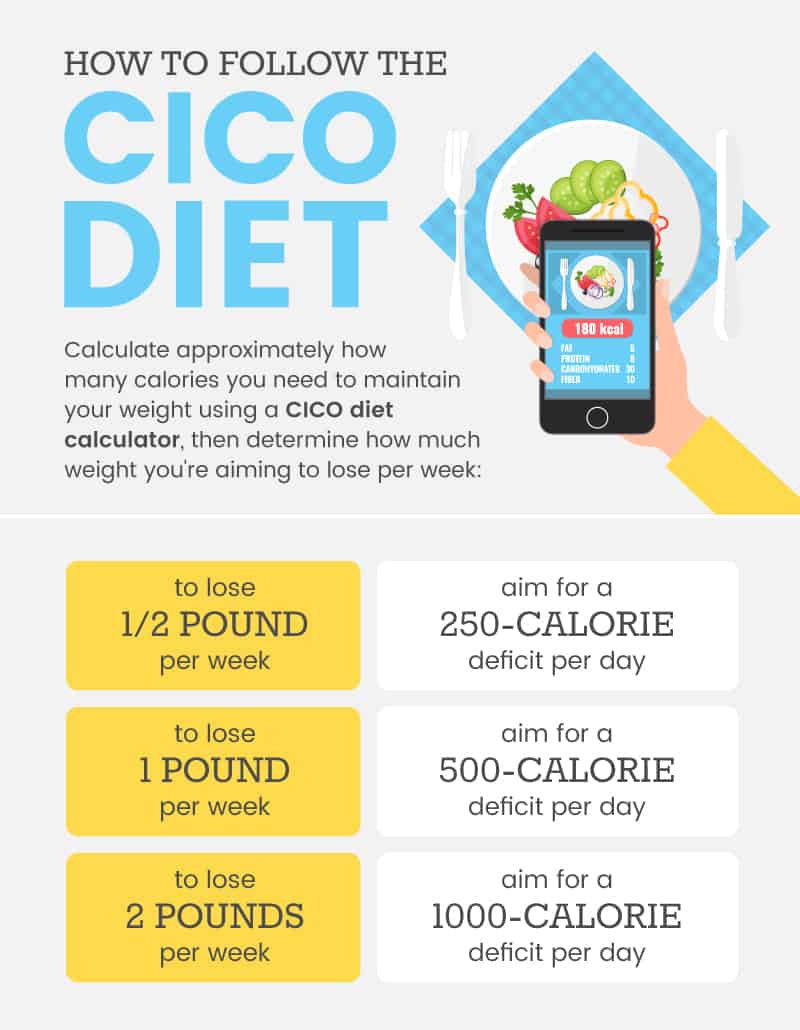

“Eat less calories than you burn.” It sounds pretty simple, right? On the CICO (“calories in, calories out”) diet, there’s no need to take protein, fats, carbs or even micronutrients into consideration because the focus is placed exclusively on one thing: calories.
It’s easy to understand why the diet has gained rapid success; it’s simple, easy to follow and lets you eat all of your favorite foods without having to memorize a long list of rules and restrictions.
But although many people swear by the simplicity of the CICO diet, it turns out that healthy weight loss may come down to more than just calories in and calories out. (Learn “how many calories should I eat a day?”) Here’s what you need to know if you’re considering starting the CICO diet.
What Is the CICO Diet?
Although the concept is hardly new, the CICO diet is a popular weight loss method. CICO, meaning “calories in, calories out,” is a diet focused solely on caloric intake. It’s based on the idea that eating less calories than you burn — regardless of where those calories come from — can help you lose weight fast.
Dieters from around the world favor the simple method because it’s super easy to follow and requires making just a few minor tweaks in your current diet pattern.
However, the CICO diet remains a subject of heated controversy. While thousands report massive success in their weight loss endeavors thanks to the easy diet, others point out that it promotes unhealthy and unsustainable eating patterns that could increase the risk of nutritional deficiencies and negative side effects.
Does the CICO Diet Work?
Since the inception of the CICO diet, the Internet has been flooded with testimonials and rave reviews reporting major weight loss by simple calorie cutting. People who claim to have tried just about every fad diet under the sun have posted about how this is the first thing to actually work for them. So does this controversial diet actually live up to the hype?
The CICO diet can definitely help some people lose weight. By reducing your caloric intake and upping your exercise, you expend more calories than you take in, which is essentially the key to successful weight loss.
That being said, there’s much more to consider when it comes to weight loss, and counting your calories just barely scrapes the surface. While there are several benefits to the CICO diet, there are also quite a few downsides, and while counting calories can definitely be an effective strategy for weight loss, there may be some better alternatives to help you drop the weight — and keep it off for good.
Benefits
1. It Can Help Promote Weight Loss
The CICO diet can be effective in its main purpose of promoting weight loss. In order to lose weight, a calorie deficit must be achieved. This means that you need to consume less calories than you expend on a daily basis.
There are a multitude of studies demonstrating that cutting down on your calories can be an effective method for weight loss. In fact, according to a review conducted by the National Institutes of Health, low-calorie diets helped reduce belly fat and lower body weight by an average of 8 percent over a period of three to 12 months.
One pound of fat is equal to about 3,500 calories. By reducing your caloric intake to 500 calories less than the amount you’re burning each day, you can theoretically lose about one pound per week.
2. Losing Weight Can Benefit Health
If you’re overweight, losing even a small amount of weight can have some major benefits when it comes to your health. For example, a 2012 study published in the Diabetes Educator showed that losing just 10 percent of body weight resulted in significant reductions in blood sugar among those with type 2 diabetes. Meanwhile, other studies show that weight loss can reduce risk factors of heart disease, improve symptoms of sleep apnea and even reduce joint pain.
Similarly, a paper published by the Washington University School of Medicine reported that moderate caloric restriction with adequate nutrition may protect against obesity, diabetes, inflammation, high blood pressure, heart disease and even cancer.
Promising research has shown that cutting calories long-term while still providing adequate nutrition can increase longevity in animals, although it remains unclear if the same holds true for humans.
Other potential benefits of long-term caloric restriction include improved heart health, reduced inflammation, decreased oxidative stress and a delay in the onset of age-related disease.
3. It’s Flexible and Easy to Follow
Many people start a new diet only to give it up a few weeks later because it’s overly restrictive and difficult. One of the main reasons that the CICO diet has rapidly gained traction is because it’s simple and allows you to eat whatever you’d like, provided it fits into your daily calorie allotment.
In fact, pizza, pasta and burgers can all fit into the CICO diet, so long as you limit your portion sizes and burn more calories throughout the day than you consume. This makes it an especially appealing option for those who don’t want to follow a strict dietary regimen or stop eating their favorite foods altogether.


Downsides
1. Weight Loss on the CICO Diet May Not Be Sustainable
While the CICO diet may be effective at promoting weight loss, it is likely only a short-term solution. The CICO diet focuses exclusively on limiting your calorie intake rather than building healthy habits, so returning to your normal diet after achieving your weight loss goals could lead to weight regain.
READ RELATED: ‘I’m a Gastroenterologist, and Here’s What Happens When You Swallow Gum—And How Long It Takes To Exit Your System’
Behavior modification, on the other hand, involves altering certain habits or patterns that may contribute to obesity, such as a lack of physical activity or emotional overeating. Rather than simply counting calories, this approach can help promote lifestyle changes that foster long-term success, and it has been shown to be effective for losing and keeping excess weight off. An example is intuitive eating.
2. The Focus Is on Calories, Not Nutrients
What you eat can have a major impact on your health. Studies show that heart disease, diabetes, certain types of cancer, eye conditions and even some birth defects can be prevented through a healthy diet and lifestyle.
One of the major problems with the CICO diet is that the emphasis is on how many calories you eat rather than the nutrients in your diet. This can lead to some major problems, ranging from protein deficiency to a lack of certain essential nutrients that your body needs, such as calcium, potassium and iron.
Nutritional deficiencies are associated with a host of health problems, such as impaired immune function, neurological problems and osteoporosis.
Instead of focusing solely on the amount of calories you consume, a healthy diet should be well-balanced (with the three macronutrients — carbs, fat and protein — taking up at least 20 percent of the daily calories) and include a wide array of nutrients to ensure you meet your daily needs.
3. There Are Other Factors to Consider
The CICO diet oversimplifies an incredibly complex subject. The truth is that weight loss is multifactorial, and eating too many calories is not always the reason behind overweight or obesity.
Hypothyroidism, for example, is a common contributor to weight gain. Other causes of unintentional weight gain include hormone changes, fluid retention, the use of certain medications, and conditions like Cushing’s syndrome and polycystic ovary syndrome.
Additionally, meticulously counting your calories may not be necessary for everyone. For some people, simply swapping out some carbohydrates for protein foods can promote satiety and aid in weight loss while others may find that setting a regular sleep schedule or minimizing stress levels could be enough to keep their waistlines in check.
How to Follow the CICO Diet
The premise of the CICO diet is simple: Calculate approximately how many calories you need to maintain your weight using a CICO diet calculator or calorie calculator, then determine how much weight you’re aiming to lose per week. Here’s how big your calorie deficit needs to be in order to lose a certain number of pounds per week:
- To lose 1/2 pound per week, aim for a 250-calorie deficit per day
- To lose one pound per week, aim for a 500-calorie deficit per day
- To lose two pounds per week, aim for a 1,000-calorie deficit per day
Subtract this number from your maintenance calories to calculate how many calories you should consume each day. For example, if you need about 2,000 calories to maintain your weight, consuming 1,750 calories each day should theoretically lead to half a pound of weight loss per week while consuming 1,500 calories per day would lead to one pound of weight loss per week.
You can decrease your daily calorie count by either eating less or exercising. If you’re aiming for 1,500 calories per day but burn off 500 on the treadmill, that means that you can actually eat up to 2,000 calories each day to still lose weight.
There are plenty of options for tracking both your intake and physical activity once you get started. Most people choose to use a CICO app or calorie counter; popular choices include MyFitnessPal, Noom and Yazio.
Because the diet is based solely on caloric intake, pretty much any food can fit on the CICO diet, provided it’s within your caloric allotment. That means that you can fill up on cake, pizza and fries — as long as you’re still under your calorie goal for the day.
However, that doesn’t mean that you should be loading up on the junk food. To optimize your diet, you should be including plenty of protein foods plus fiber-rich fruits and vegetables to ensure you’re getting the nutrients that you need, even with a lower calorie intake. Many calorie counting apps also allow you to count your macros like protein, fat and carbs along with select micronutrients to make sure that you’re meeting your needs.
In addition to eating plenty of nutrient-dense foods, make sure that you also minimize your intake of heavily processed and refined foods like baked goods, salty snacks, convenience foods and takeout. These foods tend to be higher in calories, sodium and fat but lower in important nutrients like protein, fiber, vitamins and minerals. Not only do they provide very little in terms of nutrition, but they’ll also likely leave you feeling hungry and craving more.


CICO Diet Modifications
Making a few easy recipe modifications can make it even easier to hit your calorie goals without having to give up your favorite foods. Fortunately, lowering the calorie count of your recipes is easier than it sounds. Here are a few ways that you can turn high-calorie guilty pleasures into CICO diet-friendly dishes:
- Pizza: Reduce the amount of cheese per slice, load up on the veggies and try a flour-free cauliflower crust instead.
- Pasta: Use a spiralizer to make veggie-based noodles out of zucchini, carrots or spaghetti squash, or experiment with calorie-free shirataki noodles.
- Rice: Grate some steamed cauliflower to mimic the taste and texture of rice in your favorite dishes. You buy frozen cauliflower rice and sauté it for a few minutes
- Burgers: Swap your bun for a lettuce wrap, and limit high-calorie toppings like cheese and sauces.
- Chips: Instead of snacking on potato chips, try baking your own veggie chips using kale, carrots or radishes.
- Mashed potatoes: Cut calories by using cauliflower or turnips in place of potatoes for this classic dish.
- Ice cream: For a low-calorie way to satisfy your sweet tooth, try blending frozen bananas to make a homemade soft serve.
Precautions
Focusing solely on cutting calories can lead to many potential problems, including nutritional deficiencies. Be sure to include a wide variety of healthy foods in your diet and monitor your micronutrients carefully to prevent adverse side effects.
Symptoms like fatigue; changes in skin, hair or nails; numbness; irritability; or bleeding gums can all be signs of nutrient deficiencies. If you experience these or any other negative symptoms, consult with your doctor or dietitian.
Additionally, dropping your caloric intake too low can lead to starvation mode, a condition that can slow down metabolism and stop weight loss altogether. It’s generally recommended not to dip below 1,200 calories per day, although this number might be higher depending on your size and gender. Make sure you’re eating enough and avoid cutting your calories too low to avoid going into starvation mode.
Final Thoughts
- For some people, the CICO diet can help promote weight loss, which can come with many health benefits. The diet is also easy to follow and flexible.
- On the other hand, focusing exclusively on caloric consumption may not be sustainable, can lead to nutrient deficiencies and doesn’t take into account the many other factors that play a role in weight loss.
- Use a CICO calculator to estimate how many calories you need for weight maintenance, then subtract 250–1,000 calories per day to create a calorie deficit and lose between half a pound to two pounds weekly.
- Ideally, however, calorie counting should be used in conjunction with a nutritious, well-balanced diet and positive behavior changes to foster a healthy lifestyle.
!function(f,b,e,v,n,t,s)
{if(f.fbq)return;n=f.fbq=function(){n.callMethod?
n.callMethod.apply(n,arguments):n.queue.push(arguments)};
if(!f._fbq)f._fbq=n;n.push=n;n.loaded=!0;n.version=’2.0′;
n.queue=[];t=b.createElement(e);t.async=!0;
t.src=v;s=b.getElementsByTagName(e)[0];
s.parentNode.insertBefore(t,s)}(window, document,’script’,
‘
fbq(‘init’, ‘3475171552810057’);
fbq(‘track’, ‘PageView’);




